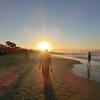Looking for budget stays in El Hoyo? This section is designed to save you time, money, and unnecessary stress. We've got insider tips to help you find affordable hostels and the cheapest places to stay in El Hoyo.

El Hoyo, Argentina, is a small village in the northwest of the Chubut Province. The Chilean border is only eighteen kilometres away, but there is no official road leading straight from El Hoyo to Chile. The area is very rural and it is a very suitable place for eco-tourism. Hiking, camping, biking, and many other outdoor activities are very popular in this part of the region. The cultivation of fruits such as berries and strawberries are the biggest economic factor for the village. The settlement of El Hoyo was founded in the mid-twentieth century and can be translated as “the hole” in English. The name derives from the topographical features of the valley where the village is located.
Around three thousand people live in the small village; therefore, the number of accommodations such as El Hoyo, Argentina hostels is limited, but you can find some guesthouses. Not all places have free and working Wi-Fi. If you are flexible and El Hoyo is totally booked out, check out El Bolsón. There you can find numerous additional hostels and guesthouses.
The theme park Millán Lemu is in the centre of Lago Puelo, a town around twelve kilometres west of El Hoyo. Surrounded by forest, plants, and grassy areas, this theme park focuses on families with kids. Mythological creatures such as dwarves, elves, and wizards are put on display; all the creatures were taken from the Celtic mythology and therefore it is unique in Patagonia.
Laberinto Patagonia is another attraction well worth seeing. This natural tree maze is only five kilometres away from the centre of the village. The founder considers the maze as a symbol of the spiritual world and the way of life offering alternative ways. Nature lovers cannot miss the Lago Puelo National Park. The park was established in the seventies and covers an area of over twenty-seven thousand square kilometres. The region was formed by glacial activities creating rivers and lakes such as Lago Puelo.
Written by Travel Expert El Hoyo
 Flo
Flo